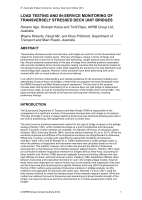Bridges

Load Testing and in-Service Monitoring of Transversely Stressed Deck Unit Bridges
- Publication no: ABC-SAS302-14
- Published: 22 October 2014
- PDF (free) Download
Transversely stressed precast concrete deck unit bridges are common on the Queensland road network for small and medium spans. This type of bridge is unique in terms of design and performance in that there are no shear keys and transverse post-tensioning is achieved through high-tensile reinforcing bars, rather than tendons. Furthermore the outside upright kerb units are significantly stiffer than the internal deck units. Recent analytical assessments of this type of bridge have identified problems associated with accurate modelling of the structural system raising concerns that the theoretical models do not represent actual performance under loads regarding the transverse live load distribution and overall bridge deck capacity. However, these structures have been performing well under normal traffic with no visual evidence of structural distress.In an effort to improve understanding and/or validate guidelines for the structural modelling and assessment of typical deck unit bridges, a three-year test program has been proposed and developed under the ARRB/TMR research agreement. The first year of the program includes static and dynamic load testing of an in-service deck unit type bridge in Queensland under known loads, as well as monitoring the behaviour of the bridge under normal traffic. This paper presents details and results of this load test and long-term monitoring, including preliminary findings.
Related publications
ABC2022-110-22
Latest Bridges News
